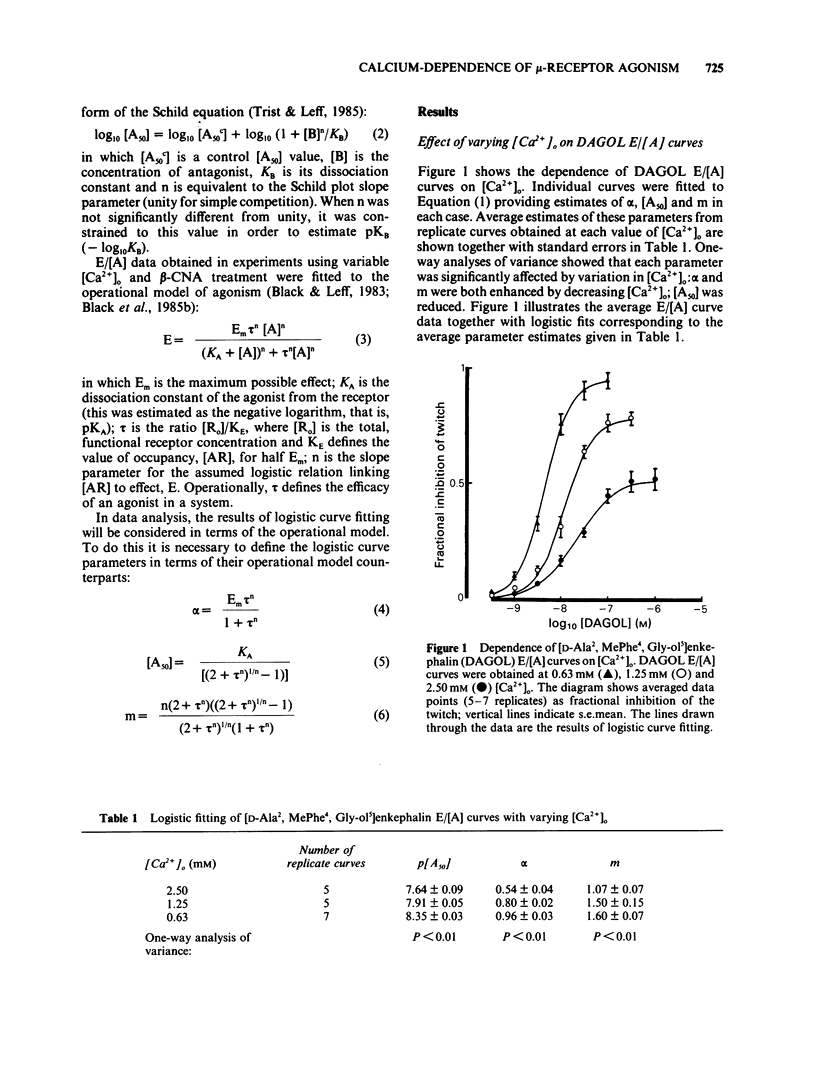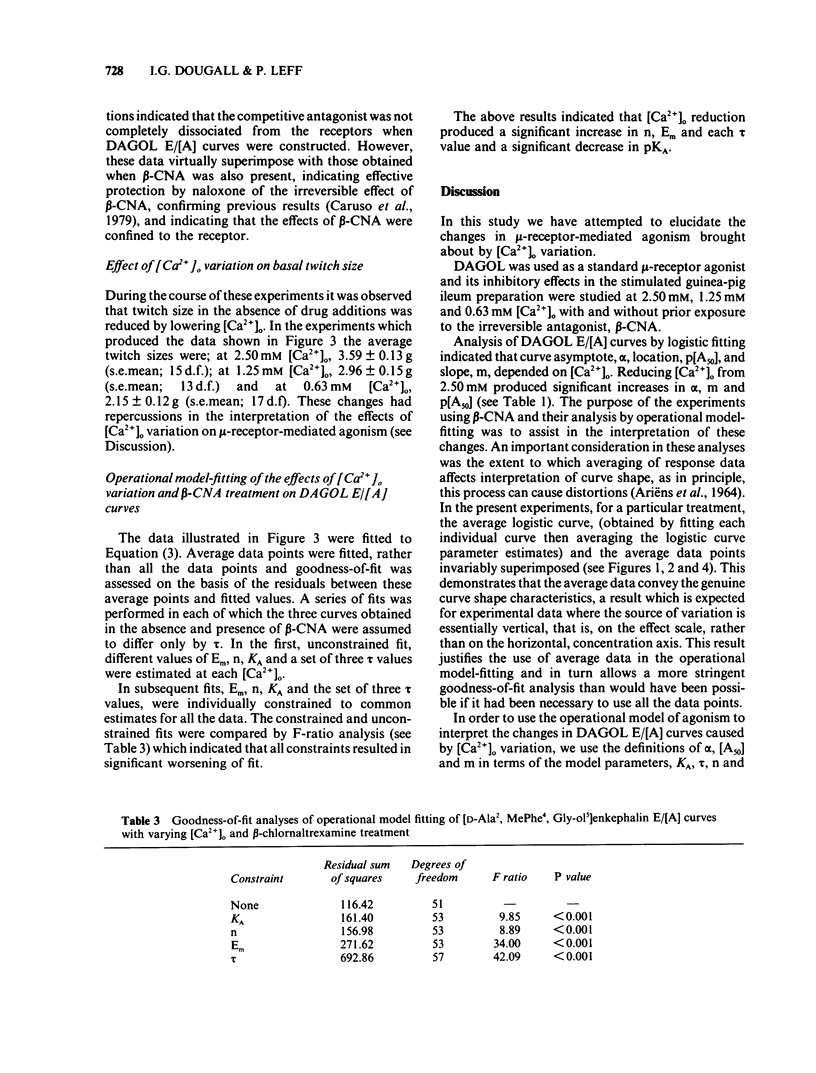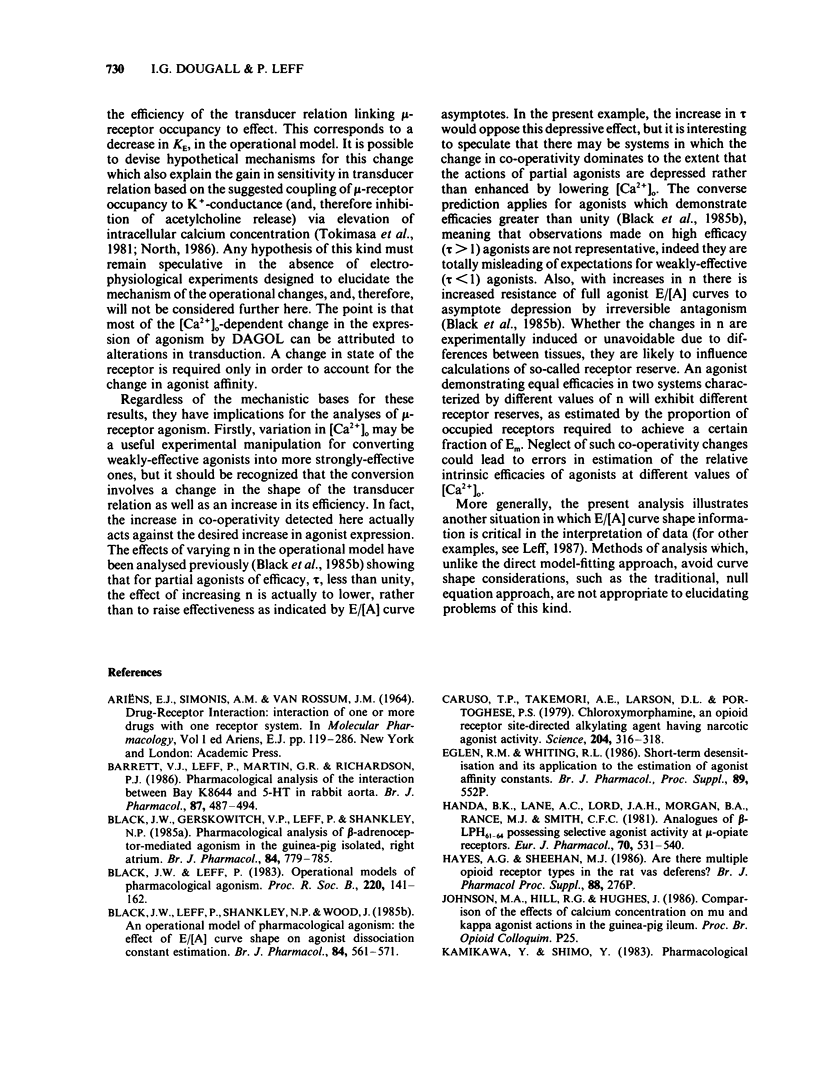Abstract
1 A number of studies in isolated tissues have shown that mu-opioid-receptor-mediated agonism can be augmented or potentiated with reduction in extracellular calcium concentration [( Ca2+]o). These effects have been ascribed to alterations in post-receptor coupling but the nature of the changes involved have not been quantitatively elucidated. 2 In this paper, logistic curve-fitting and operational model-fitting (Black & Leff, 1983) were used to analyse the effects of variations in [Ca2+]o on the mu-receptor-mediated effects of [D-Ala2, MePhe4, Gly-ol5]enkephalin (DAGOL) in the isolated, coaxially-stimulated ileum of the guinea-pig. At each value of [Ca2+]o, the effects of irreversible receptor alkylation by beta-chlornaltrexamine (beta-CNA) were also investigated. 3 From these analyses it is concluded that with reduction in [Ca2+]o the efficacy of DAGOL in this system is increased and the sensitivity of the transducer relation is also enhanced, the latter indicating a trend towards positive co-operativity. Reduction of [Ca2+]o also appeared to produce a reduction in agonist affinity. 4 Experimental manipulation of [Ca2+]o may provide a useful means of enhancing mu-agonist efficacy, allowing detection of agonism in compounds with low intrinsic efficacies. However, the accompanying change in co-operativity of the transducer relation must be considered when quantifying agonism under these conditions.
Full text
PDF








Selected References
These references are in PubMed. This may not be the complete list of references from this article.
- Barrett V. J., Leff P., Martin G. R., Richardson P. J. Pharmacological analysis of the interaction between Bay K 8644 and 5-HT in rabbit aorta. Br J Pharmacol. 1986 Mar;87(3):487–494. doi: 10.1111/j.1476-5381.1986.tb10190.x. [DOI] [PMC free article] [PubMed] [Google Scholar]
- Black J. W., Gerskowitch V. P., Leff P., Shankley N. P. Pharmacological analysis of beta-adrenoceptor-mediated agonism in the guinea-pig, isolated, right atrium. Br J Pharmacol. 1985 Mar;84(3):779–785. doi: 10.1111/j.1476-5381.1985.tb16161.x. [DOI] [PMC free article] [PubMed] [Google Scholar]
- Black J. W., Leff P. Operational models of pharmacological agonism. Proc R Soc Lond B Biol Sci. 1983 Dec 22;220(1219):141–162. doi: 10.1098/rspb.1983.0093. [DOI] [PubMed] [Google Scholar]
- Caruso T. P., Takemori A. E., Larson D. L., Portoghese P. S. Chloroxymorphamine, and opioid receptor site-directed alkylating agent having narcotic agonist activity. Science. 1979 Apr 20;204(4390):316–318. doi: 10.1126/science.86208. [DOI] [PubMed] [Google Scholar]
- Handa B. K., Land A. C., Lord J. A., Morgan B. A., Rance M. J., Smith C. F. Analogues of beta-LPH61-64 possessing selective agonist activity at mu-opiate receptors. Eur J Pharmacol. 1981 Apr 9;70(4):531–540. doi: 10.1016/0014-2999(81)90364-2. [DOI] [PubMed] [Google Scholar]
- Kamikawa Y., Shimo Y. Pharmacological characterization of the opioid receptor in the submucous plexus of the guinea-pig oesophagus. Br J Pharmacol. 1983 Apr;78(4):693–699. doi: 10.1111/j.1476-5381.1983.tb09422.x. [DOI] [PMC free article] [PubMed] [Google Scholar]
- Leff P., Martin G. R., Morse J. M. Application of the operational model of agonism to establish conditions when functional antagonism may be used to estimate agonist dissociation constants. Br J Pharmacol. 1985 Jul;85(3):655–663. doi: 10.1111/j.1476-5381.1985.tb10561.x. [DOI] [PMC free article] [PubMed] [Google Scholar]
- Opmeer F. A., Van Ree J. M. Competitive antagonism of morphine action in vitro by calcium. Eur J Pharmacol. 1979 Feb 1;53(4):395–397. doi: 10.1016/0014-2999(79)90467-9. [DOI] [PubMed] [Google Scholar]
- Opmeer F. A., Van Ree J. M. Differential involvement of calcium in acute and chronic opioid action in the guinea-pig ileum in vitro. J Pharmacol Exp Ther. 1980 Apr;213(1):188–195. [PubMed] [Google Scholar]
- Portoghese P. S., Larson D. L., Jiang J. B., Caruso T. P., Takemori A. E. Synthesis and pharmacologic characterization of an alkylating analogue (chlornaltrexamine) of naltrexone with ultralong-lasting narcotic antagonist properties. J Med Chem. 1979 Feb;22(2):168–173. doi: 10.1021/jm00188a008. [DOI] [PubMed] [Google Scholar]
- Tokimasa T., Morita K., North A. Opiates and clonidine prolong calcium-dependent after-hyperpolarizations. Nature. 1981 Nov 12;294(5837):162–163. doi: 10.1038/294162a0. [DOI] [PubMed] [Google Scholar]
- Trist D. G., Leff P. Quantification of H2-agonism by clonidine and dimaprit in an adenylate cyclase assay. Agents Actions. 1985 Apr;16(3-4):222–226. doi: 10.1007/BF01983145. [DOI] [PubMed] [Google Scholar]


